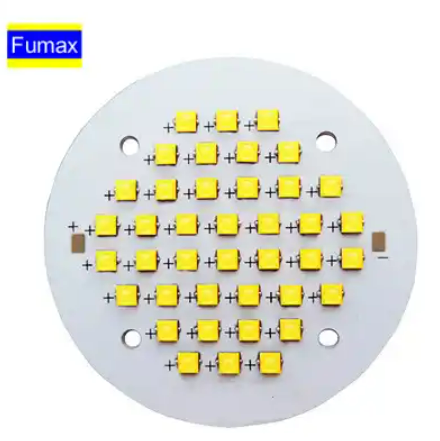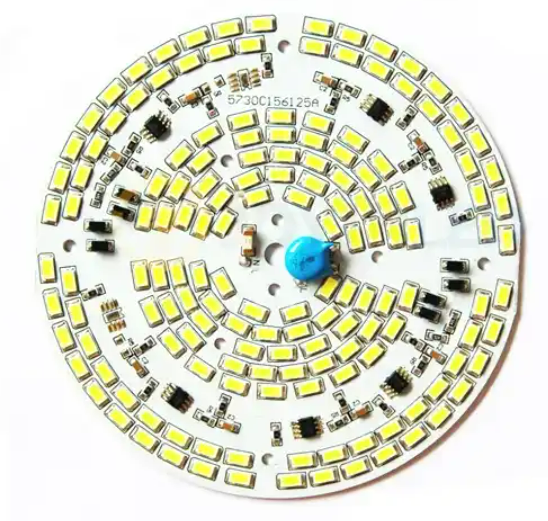LED PCB electronic circuit design and manufacturing solutions include steps such as determining design requirements, schematic design, PCB board design, electronic component selection, verification and optimization of design solutions.
During the manufacturing process, steps such as making molds and steel mesh, purchasing raw materials, PCB board processing, electronic component welding, and finished product inspection and testing are required. Ultimately, it is necessary to ensure that the LED PCB produced meets the design requirements and quality standards to provide customers with efficient, energy-saving, and environmentally friendly LED lighting solutions.

introduction
With the continuous development of science and technology, LED lighting is used more and more widely in various fields. In order to meet the needs of LED lighting in different fields, this article will focus on the design and manufacturing solutions of LED PCB electronic circuits. LED PCB is a circuit board that integrates LED lamp beads and electronic components on the same PCB board. It has the advantages of high efficiency, energy saving, and environmental protection. It is widely used in indoor and outdoor lighting, display screens, traffic lights and other fields.
LED PCB electronic circuit design
Determine design requirements
Before designing an LED PCB electronic circuit, you must first clarify the design requirements, including the model, quantity, and arrangement of LED lamp beads, PCB board material, size, thickness, and types and specifications of electronic components, etc. According to the design requirements, determine the overall design plan.
Schematic design
Carry out schematic design according to the design plan. In the schematic diagram, the LED lamp beads and electronic components are drawn according to a certain circuit connection relationship to realize the LED lighting function. At the same time, issues such as heat dissipation design and electrical insulation must be taken into consideration to ensure the safety and stability of the circuit board.
PCB board design
Carry out PCB board design based on the schematic design results. In PCB board design, factors such as component layout, circuit routing, and pad size must be taken into consideration. At the same time, appropriate PCB board material and thickness must be selected to meet actual application needs. In addition, 3D modeling is required to better observe and evaluate the design effect of the PCB board.
Electronic component selection
Select appropriate electronic component models and specifications based on design requirements and schematic diagrams. When selecting components, it is necessary to consider parameters such as their withstand voltage value, current value, and thermal performance to ensure that they can meet the needs of actual applications. At the same time, the procurement cost and availability of components also need to be considered to ensure the economy and feasibility of the design solution.
Verification and optimization of design solutions
After the design is completed, the design solution needs to be verified and optimized. The performance of the circuit board is evaluated and tested through simulation experiments and practical application tests. If problems are found, the design solution needs to be adjusted and optimized to improve the performance and reliability of the LED PCB electronic circuit.

LED PCB manufacturing solution
Make molds and steel mesh
Make molds and steel mesh according to the designed PCB drawings. The mold is used to make the shape and size of the PCB board, and the stencil is used to weld the electronic components to the PCB board. When making molds and stencils, accuracy and quality must be ensured to ensure that the produced PCB boards meet the design requirements.
Purchase of raw materials
According to the design plan and production plan, purchase the required raw materials, including PCB sheets, electronic components, solder, etc. When purchasing, you need to pay attention to issues such as raw material quality and delivery time to ensure the smooth progress of the production plan.
PCB board processing
Send the finished PCB board to the production line for processing. During the processing, process operations such as coating, etching, and drilling are required to ensure that the shape, size, circuitry, etc. of the PCB board meet the design requirements. At the same time, quality control links such as inspection and testing are also required to ensure that the PCB boards produced meet quality standards.
Electronic component welding
Weld the purchased electronic components to the PCB board according to the designed circuit connection relationship. During the welding process, attention needs to be paid to the welding quality and process requirements to ensure that each component can be firmly welded to the PCB board. At the same time, quality monitoring links such as inspection and testing are also required to ensure welding quality and circuit board stability.
Finished product inspection and testing
After all production processes are completed, quality control links such as inspection and testing of the finished product need to be carried out. Inspection and testing work includes appearance inspection, performance testing and other links to ensure that the LED PCB produced meets the design requirements and quality standards. If problems are found, they need to be dealt with and resolved in a timely manner to ensure product quality and stability. At the same time, relevant certification work is also required, such as ISO9001 quality management system certification, etc., to ensure the standardization of the production process and the strictness of quality control.